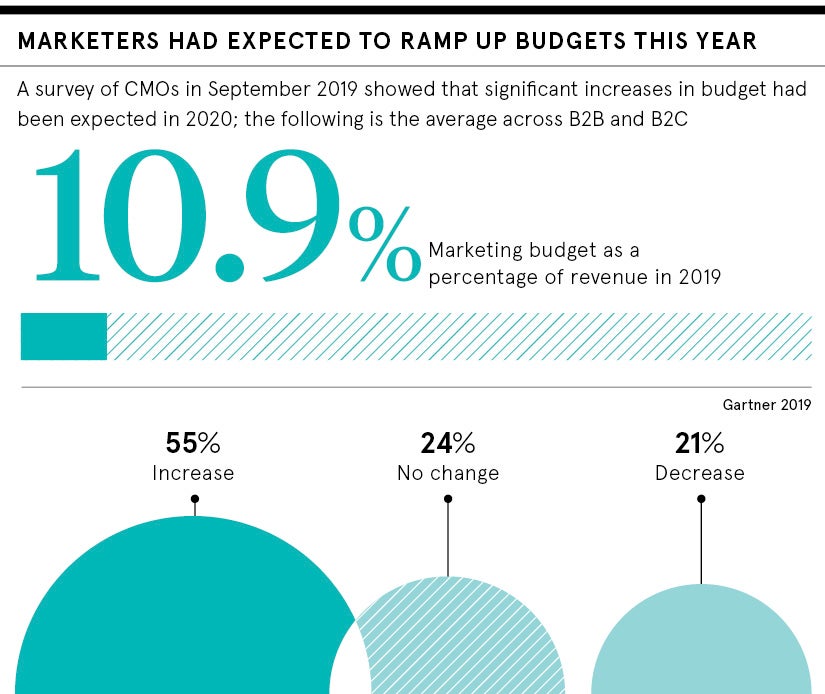Chief marketing officers, or CMOs, have long understood the importance of working towards long-term marketing goals and building resilient brands, which consumers turn to in good times and bad. But few could have predicted such a shocking turn of events in 2020.
With the coronavirus pandemic and an increasingly gloomy economic outlook now testing even the most resilient brands, CMOs need to make smart decisions to ensure their brands are well prepared not only for immediate challenges, but to capitalise on the new customer buying behaviours. This will position them for recovery and long-term growth.
To spend or not to spend?
All signs had pointed to 2020 being the year marketers refocused on long-term marketing goals, moving away from the damaging short-term strategies that have undermined brand-building in recent years. The WARC Marketer’s Toolkit 2020 reveals that 40 per cent of marketers surveyed intended to pivot back to long-term brand-building in 2020, with adtech and sustainability also top of mind.
How things change.
Now, as revenues slump in the wake of COVID-19, many CMOs are being forced to update their marketing plan in real time. Often, at the heart of those conversations, is one important question: should the brand reduce advertising spend to cut costs or stay the course?
Brands including Coca-Cola, adidas and Google have already cut back marketing spend as a result of the COVID-19 crunch. These brands are far from alone. The most recent Advertising Association/WARC Expenditure Report, released at the end of April, forecast a £4.23-billion drop in advertising expenditure this year in the UK alone, a huge 16.7 per cent fall from 2019’s record year, with double-digit declines across both traditional and digital channels (see more on the page ten infographic).
Making smart decisions now for long-term growth
According to Peter Field, a leading researcher on marketing effectiveness, going dark and cutting advertising entirely is the “very worst” decision a brand could make if they want to thrive in the post-COVID-19 recovery.
“Going dark is very dangerous; do whatever you can to avoid it,” he warns, adding that brands taking this path should “expect market share loss and a reduction of pricing power in recovery”.
Field advises that, where possible, CMOs should maintain long-term brand-building activity through these challenging times. “Do not go dark unless survival depends on it. Do not allow share of voice to fall below share of market. Do not go short in marketing terms,” he says.
By making well-considered decisions now, marketers can prioritise maintaining market share through the downturn and ensure the brand is well positioned for growth when consumers start spending again.
“Smart brands will take advantage of the falling cost of buying share of voice to maintain or even build their brand-building presence during recession for less money. They will enjoy long-term returns on their investment that they simply could not achieve during normal times, but will need to shoulder a short-term hit to profitability. It will be well worth it, however,” says Field.
“Marketers must ensure the brand is primed and ready to benefit. It will be too late if you wait for recovery to act. Buying in a sellers’ media marketplace is not a good plan.”ennn
Capitalising on new buying behaviour
Marketers are already finding hope in new consumer purchase behaviour. A sizeable uptick in ecommerce transactions is one emerging opportunity.
Unilever’s chief executive Alan Jope notes in a recent earnings call that Unilever’s ecommerce sales had increased 36 per cent in the first quarter of the year. These are exciting green shoots for brands able to pivot into online retailing or dial up their existing investment in ecommerce.
P&G, one of the world’s largest advertisers, has elected to double down on marketing investment as demand for its products has soared in recent weeks. The company boosted its third-quarter marketing spend by 1.9 per cent year on year, with a focus on the healthcare, beauty and babycare categories.
“We need to work hard to ensure we maintain mental and physical availability to the greatest extent possible, so that those consumers return to their beloved and trusted brands, which are ours, as they’re more fully available,” says Jon Moeller, chief financial officer of P&G, on the company’s recent quarterly earnings call at the end of April.
“There’s big upside here in terms of reminding consumers of the benefits that they’ve experienced from our brands and how they’ve served them and their families’ needs, which is why this is not a time to go off air,” says Moeller.
Build meaningful connections for the long-term
Even those dealing with a reduced media budget need to find ways to remain visible. This means looking to connect with consumers outside just advertising and executing on the core promise of the brand.
According to Raja Rajamannar, CMO at Mastercard, marketing fundamentals are more important than ever in this time, especially brand trust and customer centricity.
“The most important foundational element is trust. This is a time of need and if you are not friends with consumers, they are not going to talk to you later. It’s very important that brands build trust at this point in time. You are trusted, validated or invalidated during the time of crisis,” says Rajamannar.
Field advises marketers struggling with budget cuts to look beyond just advertising to pursue their long-term marketing goals during COVID-19. “Look for other ways to keep a presence at relatively low cost: communications to existing customers, product innovation already in the pipeline, public relations initiatives, high-visibility behaviours and commitments that are consistent with the mood of the nation,” he concludes.

